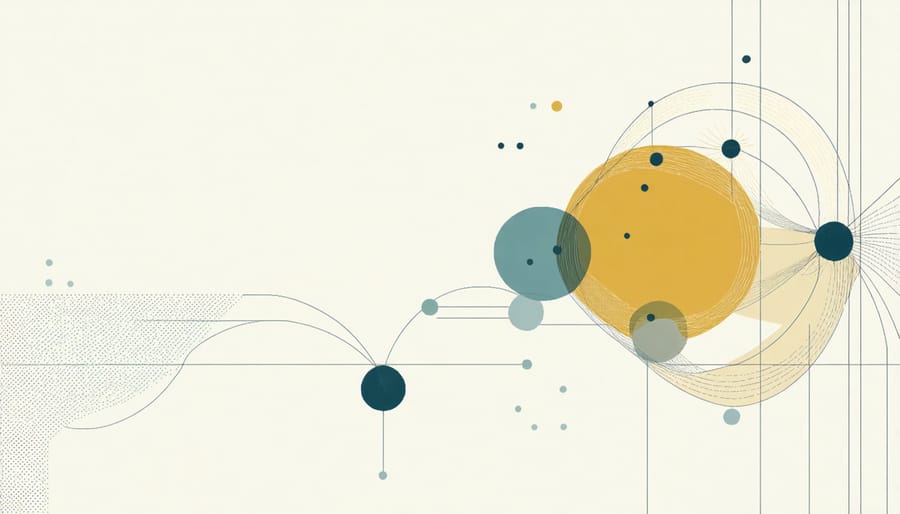
Imagine transforming your workday from a chaotic rush into a purposeful journey – this is the power of mindful work. In today’s always-on digital world, where notifications compete for our attention and deadlines loom constantly, incorporating mindfulness into our professional lives isn’t just a luxury – it’s essential for both productivity and wellbeing.
Mindful work goes beyond basic meditation or deep breathing exercises (though these are valuable tools). It’s about bringing full awareness to each task, each interaction, and each decision we make throughout our workday. When we work mindfully, we’re not just going through the motions or racing to the next deadline; we’re fully present in each moment, making conscious choices about where to direct our energy and attention.
Recent studies show that professionals who practice mindful work report 31% lower stress levels and a 20% increase in productivity. But perhaps more importantly, they describe feeling more connected to their work, more satisfied with their achievements, and better equipped to handle workplace challenges.
The beauty of mindful work lies in its accessibility – you don’t need special equipment or hours of free time. Simple shifts in how you approach your daily tasks can transform your entire work experience, leading to better outcomes and greater satisfaction in both your professional and personal life.
What Makes Work Truly Mindful?
The Difference Between Being Busy and Being Present
Have you ever caught yourself juggling multiple tasks, feeling productive but somehow disconnected from the moment? Many of us confuse being busy with being effective, but there’s a crucial difference between the two. While multitasking might give us the illusion of accomplishment, it often leaves us feeling scattered and exhausted.
The good news is that you can transform busy days into calm moments by shifting from a state of constant doing to one of conscious being. Think of it like the difference between frantically stirring multiple pots on the stove versus mindfully focusing on creating one perfect dish.
Being present means giving your full attention to the task at hand, whether it’s responding to an email, participating in a meeting, or even taking a short break. Instead of rushing through your to-do list, you’re creating space to fully engage with each moment. This shift not only improves the quality of your work but also reduces stress and increases job satisfaction.
When we choose presence over busyness, we discover that productivity isn’t about doing more – it’s about doing things with greater intention and awareness.

Simple Mindfulness Techniques for Your Workday
Let’s explore some simple yet powerful mindfulness practices you can weave into your workday. I’ve found that even the smallest moments of mindfulness can transform a hectic day into a more balanced experience.
Start your morning by taking three mindful breaths before checking your emails. This tiny ritual helps set a calm tone for the day ahead. Throughout your workday, try practicing the “3-3-3” technique: pause to notice three things you can see, three things you can hear, and three things you can feel. This quick grounding exercise can help you reset between tasks.
When you’re feeling overwhelmed, take a moment to try these soothing breath techniques at your desk. Simply closing your eyes and focusing on your breath for 30 seconds can help clear mental clutter.
Another favorite practice of mine is mindful typing – feel your fingers on the keyboard and notice the sound they make. During lunch, try eating without distractions for the first three bites, fully savoring the flavors and textures. These small moments of presence can create pockets of peace in even the busiest workday.
Creating Your Mindful Workspace
Designing a Calm Work Environment
Creating a calm work environment is like setting the stage for a mindful workday. I remember when I transformed my chaotic desk into a serene workspace – it was a game-changer for my productivity and peace of mind. Start by decluttering your space; a tidy desk really does lead to a tidy mind.
Choose colors that promote tranquility – soft blues, gentle greens, or warm neutrals can help create a soothing atmosphere. Natural light is your best friend, so position your desk near a window if possible. If that’s not an option, invest in a daylight lamp that mimics natural sunlight.
Consider incorporating natural elements like small plants or a desktop water fountain. The gentle sound of flowing water can mask distracting office noise while creating a peaceful ambiance. I keep a small potted succulent on my desk – it’s both beautiful and low-maintenance.
Personalize your space thoughtfully, but avoid overcrowding. A few meaningful items like a favorite photo or an inspiring quote can uplift your spirits without creating visual chaos. Pay attention to comfort too – a supportive chair and proper desk height are essential for maintaining physical well-being throughout the day.
Finally, keep essential items within arm’s reach but tucked away neatly. Use drawer organizers or desktop trays to maintain order. Remember, your workspace should feel like a sanctuary that supports both focus and relaxation.

Incorporating Wellness Elements
Creating a wellness-focused workspace isn’t just about adding plants or buying an ergonomic chair – it’s about intentionally designing your environment to support both your mental and physical health. I discovered this firsthand when I transformed my own workspace from a stress-inducing corner to a mindful sanctuary.
Start by incorporating natural elements that promote calm and focus. Position your desk near a window to benefit from natural light, which not only boosts mood but also helps regulate your circadian rhythm. Add a few low-maintenance plants to purify the air and create a connection to nature.
Movement is essential for wellness, so consider integrating standing or walking options into your workday. A standing desk converter or a dedicated space for quick stretching breaks can make a significant difference. I keep a yoga mat rolled up in the corner of my office for impromptu movement sessions when I need to reset.
Create a sensory-friendly environment by managing noise levels with noise-canceling headphones or a white noise machine. Consider using essential oils like lavender or citrus for gentle aromatherapy, but be mindful of colleagues in shared spaces.
Don’t forget the basics: proper lighting, comfortable seating, and regular hydration. Keep a water bottle visible as a reminder to stay hydrated, and set up your monitor at eye level to maintain good posture. These small changes add up to create a workspace that supports your overall well-being while enhancing your ability to work mindfully.
Mindful Career Decisions
Setting Boundaries with Purpose
Setting boundaries isn’t just about saying “no” – it’s about saying “yes” to your wellbeing and creating space for what truly matters. As someone who used to pride myself on being available 24/7, I learned the hard way that boundaries aren’t barriers; they’re bridges to a more fulfilling life.
Start by identifying your non-negotiables. Maybe it’s logging off at 6 PM to have dinner with your family, or keeping your weekends sacred for self-care. Write these down and treat them with the same respect you’d give to important client meetings.
Create rituals that signal the transition between work and personal time. I’ve found that a simple act, like changing clothes or taking a short walk after work, helps my brain switch gears. These small gestures become powerful reminders that it’s okay to step away.
Remember, setting boundaries isn’t selfish – it’s necessary for sustainable success. Try communicating your limits clearly and professionally: “I’m available between 9 AM and 5 PM, and I’ll respond to urgent matters within those hours.” This sets realistic expectations while maintaining professional relationships.
Most importantly, release the guilt. When you honor your boundaries, you show up as your best self in both work and life. Your energy is renewed, your creativity flows, and you model healthy work-life integration for others around you. Start small, stay consistent, and watch how these intentional limits actually expand your capacity for joy and productivity.
Aligning Work with Personal Values
Have you ever felt that disconnect between your work and what truly matters to you? I certainly have. Aligning our career choices with our personal values isn’t just about job satisfaction—it’s about creating a meaningful life that reflects who we are at our core.
Start by taking a moment to identify your non-negotiable values. Maybe it’s creativity, helping others, environmental sustainability, or family time. Write these down and reflect on how your current work either supports or conflicts with these principles. Through mindful emotion awareness, you can better understand how different aspects of your work affect your well-being and alignment with these values.
Consider Sarah, a marketing executive who valued authenticity and social impact. She felt increasingly disconnected from her work promoting fast fashion until she pivoted to consulting for sustainable brands. Now, her work energizes rather than depletes her.
Small shifts can make a big difference. If you value learning, could you incorporate more professional development into your current role? If community matters to you, could you initiate team volunteer programs? Sometimes, alignment doesn’t require a complete career change—it might mean reshaping your current position or bringing your values into your existing workplace.
Remember, this alignment is an ongoing journey, not a destination. As you grow and evolve, so will your values and how you express them through your work.

The Ripple Effect of Mindful Work
Better Relationships Through Presence
When we bring mindfulness into our work life, something magical happens to our relationships – both professional and personal. I noticed this transformation firsthand when I started practicing presence during my daily interactions. Instead of half-listening while checking emails, I began giving my full attention to conversations, and the difference was remarkable.
Being present allows us to truly hear not just the words, but the emotions and intentions behind them. Whether it’s a quick chat with a colleague or a deep discussion with a partner, mindful presence creates a space where genuine connection can flourish. Think about how it feels when someone is truly listening to you – that’s the gift we give others through mindful attention.
This ripple effect extends beyond individual relationships. I’ve found that building a mindful community at work naturally leads to stronger bonds and more meaningful collaborations. Team meetings become more productive, conflicts are resolved more effectively, and there’s a tangible sense of mutual respect and understanding.
The best part? These improved relationship skills naturally flow into our personal lives, creating deeper connections with family and friends. It’s like developing a superpower that enhances every interaction we have.
From Work Wellness to Life Wellness
The beauty of mindful work practices lies in their ability to extend far beyond the office walls. Once you’ve mastered mindfulness at work, you’ll naturally find yourself applying these techniques to other areas of your life. That morning breathing exercise you do before checking emails? Try it before tackling your grocery shopping. The present-moment awareness you practice during meetings can transform your family dinner conversations.
I’ve noticed that when clients start implementing mindful work practices, they often report unexpected benefits in their personal lives. One participant in our workplace wellness program shared how the three-minute mindful breaks she learned at work helped her become a more patient parent. Another found that the active listening skills she developed for client meetings dramatically improved her relationships with friends.
Consider creating mindful transitions between different life roles. Just as you mindfully close your laptop at day’s end, create small rituals that help you shift between various life aspects. These might include a brief meditation during your commute home or a mindful walk after dinner. Remember, the goal isn’t to compartmentalize but to bring awareness and intention to every moment, whether you’re in the boardroom or your living room.
As we wrap up our exploration of mindful work, remember that this journey isn’t about perfection – it’s about progress. By incorporating mindfulness into your workday, you’re not just improving your productivity; you’re transforming your entire relationship with work. Start small, perhaps with a few mindful breaths before checking your morning emails, or a moment of presence during your lunch break.
The beauty of mindful work lies in its accessibility. You don’t need special equipment or hours of free time – just a willingness to be present and aware. As someone who struggled with workplace stress for years, I’ve experienced firsthand how these simple practices can create profound changes. My own journey began with just two minutes of mindful breathing each morning, and it grew naturally from there.
Remember, mindful work isn’t another item on your to-do list; it’s a way of being that enriches every aspect of your professional life. Whether you’re managing a team, working remotely, or navigating career transitions, these practices will serve as your anchor, helping you stay centered and focused.
I encourage you to take one principle from this article and implement it tomorrow. Notice how it feels, adjust as needed, and gradually build your practice. The workplace needs more mindful individuals, and your journey starts now. Together, we’re creating a more conscious and compassionate work environment, one mindful moment at a time.



